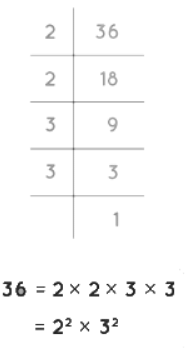Word Problem: Factors and Multiples | Mathematics for Class 4 PDF Download
Q1: Find all the factors of 36 using the division method.
Ans: We start by dividing 36 by the smallest prime number, which is 2.
We find that 36 ÷ 2 = 18. Since 18 is still divisible by 2, we continue dividing: 18 ÷ 2 = 9. Finally, 9 is not divisible by 2, so we move to the next smallest prime number, which is 3. Dividing 9 by 3, we get 9 ÷ 3 = 3. Since 3 is a prime number, we stop here.
Q2: Determine if 126 is divisible by 3 according to the divisibility rule.
Ans: To check if 126 is divisible by 3, we sum its digits: 1 + 2 + 6 = 9.
Since 9 is divisible by 3
Thus, 126 is divisible by 3 according to the divisibility rule.
Q3: Determine if 126 is divisible by 3 according to the divisibility rule.
Ans: Add the digits of 126 to check if the sum is divisible by 3.
1 + 2 + 6 = 9
1 + 2 + 6 = 9, which is divisible by 3. Therefore, 126 is divisible by 3.
Q4: Identify the common factors of 20 and 35.?
Ans: Find the factors of each number and then determine which ones are common.
Factors of 20: 1, 2, 4, 5, 10, 20.
Factors of 35: 1, 5, 7, 35.
Common factors: 1 and 5.
Note: We first find all factors of each number and then identify those that appear in both lists. These common factors are the ones that divide both numbers evenly.
Q5: If a factory produces 24 units every hour, how many units will it produce in 6 hours?
Ans: In 6 hours, the factory will produce 24 x 6 = 144 units.
Multiplying the production rate per hour by the number of hours gives the total production for the given time period.
Q6: Find out all the factors of 5.
Ans: 5 can be divided exactly only by 5 or by 1.
From 5 we can form either : 1 group of 5 or 5 groups of 1
5 has only two factors 1 and 5. Therefore, 5 is a prime number.
Q7: Find out the multiples of 2 and 3 in sequence.
Ans: 2 × 1 =2; 2 × 2 = 4; 2 × 3 = 6; 2 × 4 = 8; 2 × 5 = 10;
2 × 6 = 12; and so on.
Hence, multiples of 2 in sequence are 2, 4, 6, 8, 10, 12, 14, ...
3 × 1 =3; 3 × 2 = 6; 3 × 3 = 9; 3 × 4 = 12; 3 × 5 = 15;
3 × 6 = 18; and so on.
Hence, multiples of 3 in sequence are
3, 6, 9, 12, 15, 18, ...
Q8: Find the common multiples of 3 and 5.
Ans: Multiples of 3 – 3, 6, 9, 12, 15, 18, 21
Multiples of 5 – 5, 10, 15, 20, 25
15 is a common multiple of 3 and 5.
Indeed, 15 is the least common multiple (LCM) of 3 and 5.
Q9: Find the HCF of 6 and 9.
Ans:
Hence, HCF of 6 and 9 is 3.
Q10: Find out all the factors of 24.
Ans: 24 ÷ 1 = 24 24 ÷ 2 = 12 24 ÷ 3 = 8
24 ÷ 4 = 6 24 ÷ 6 = 4 24 ÷ 8 = 3
24 ÷ 12 = 2 24 ÷ 24 = 1
1, 2, 3, 4, 6, 8, 12 and 24 are factors of 24 as they divide 24 exactly. Hence, factors are also divisors of a number. When you divide one number by another and there is no remainder, the divisor and the quotient are factors of the fi rst number.
|
33 videos|168 docs|30 tests
|
















